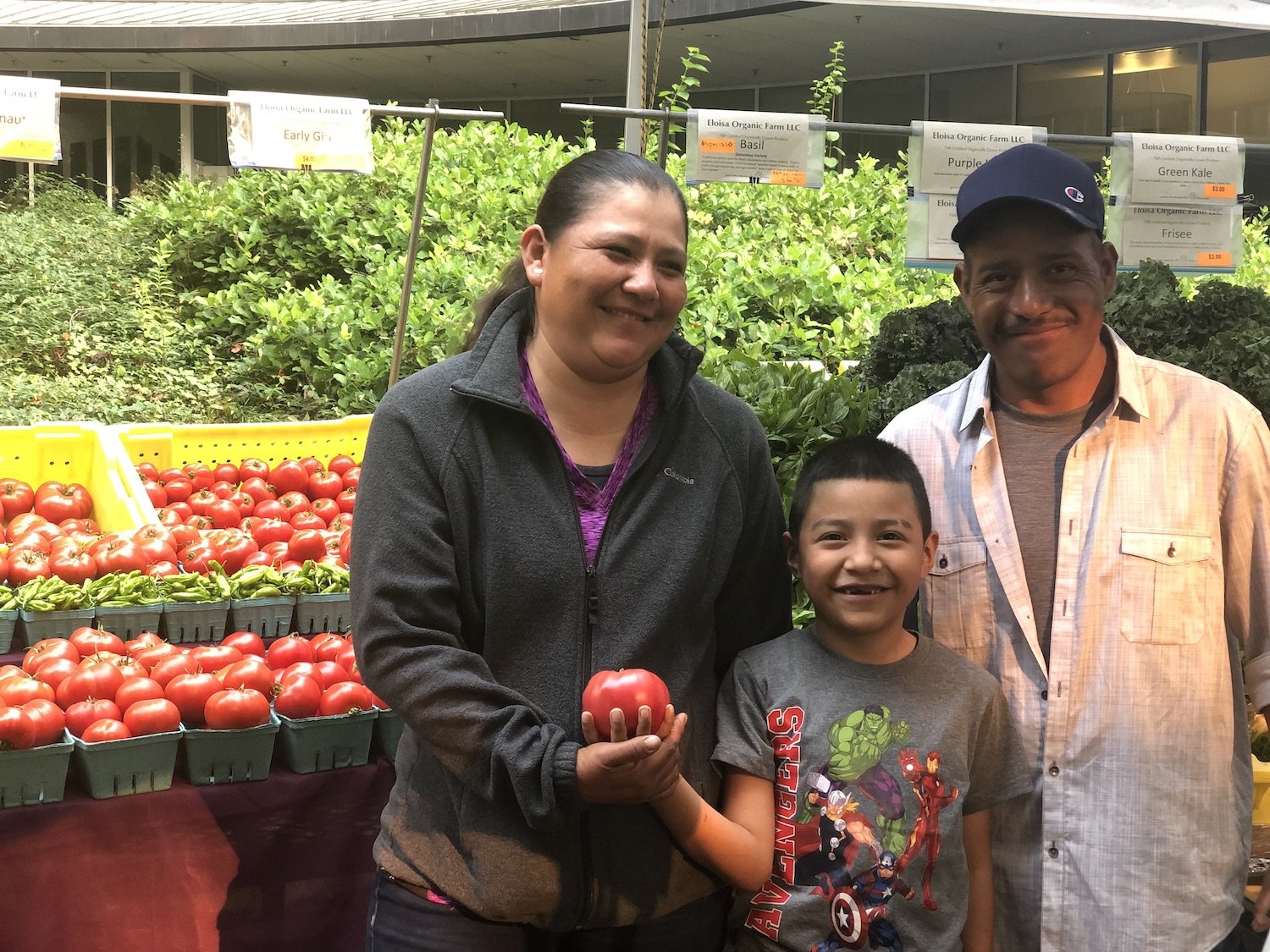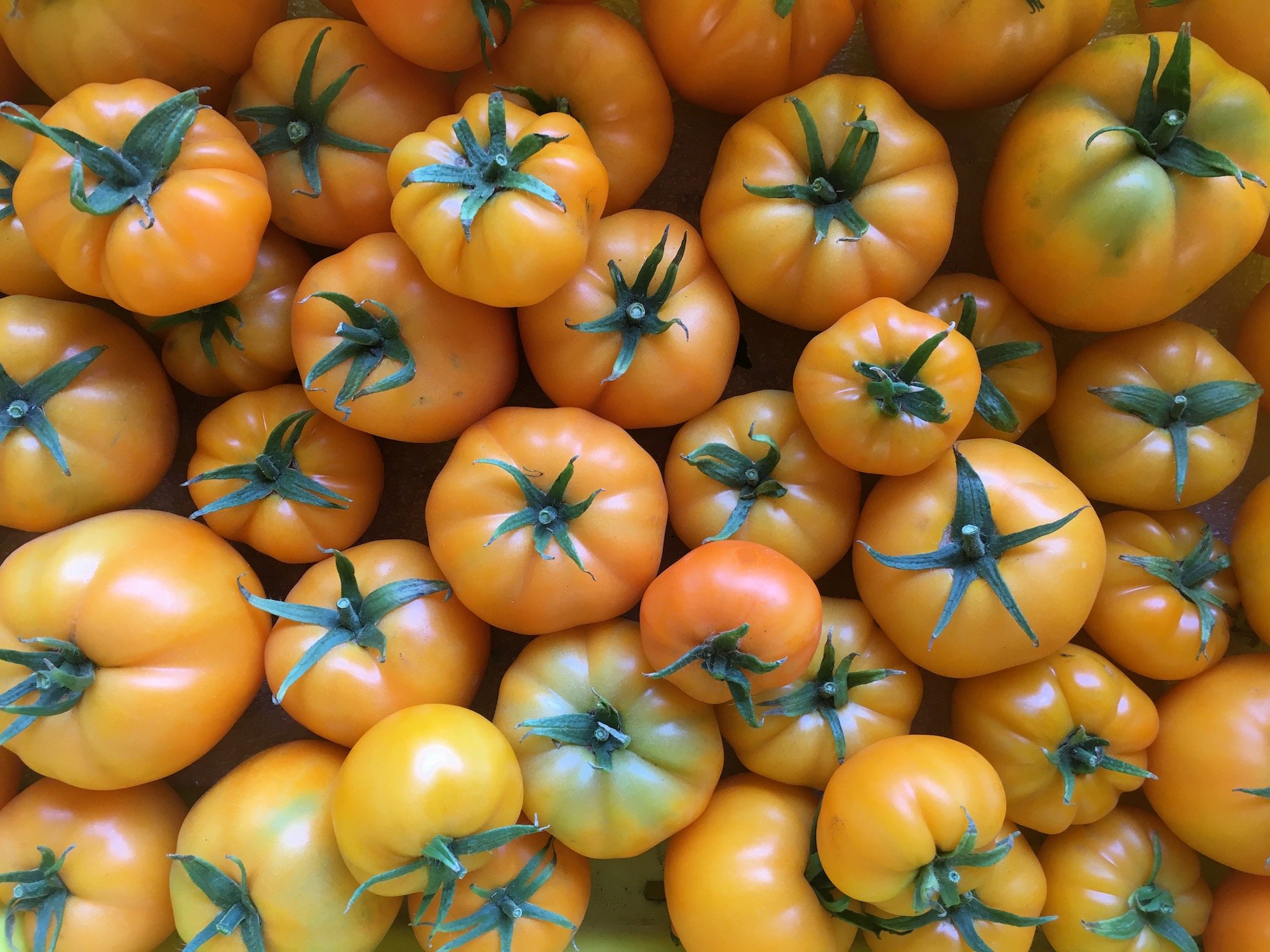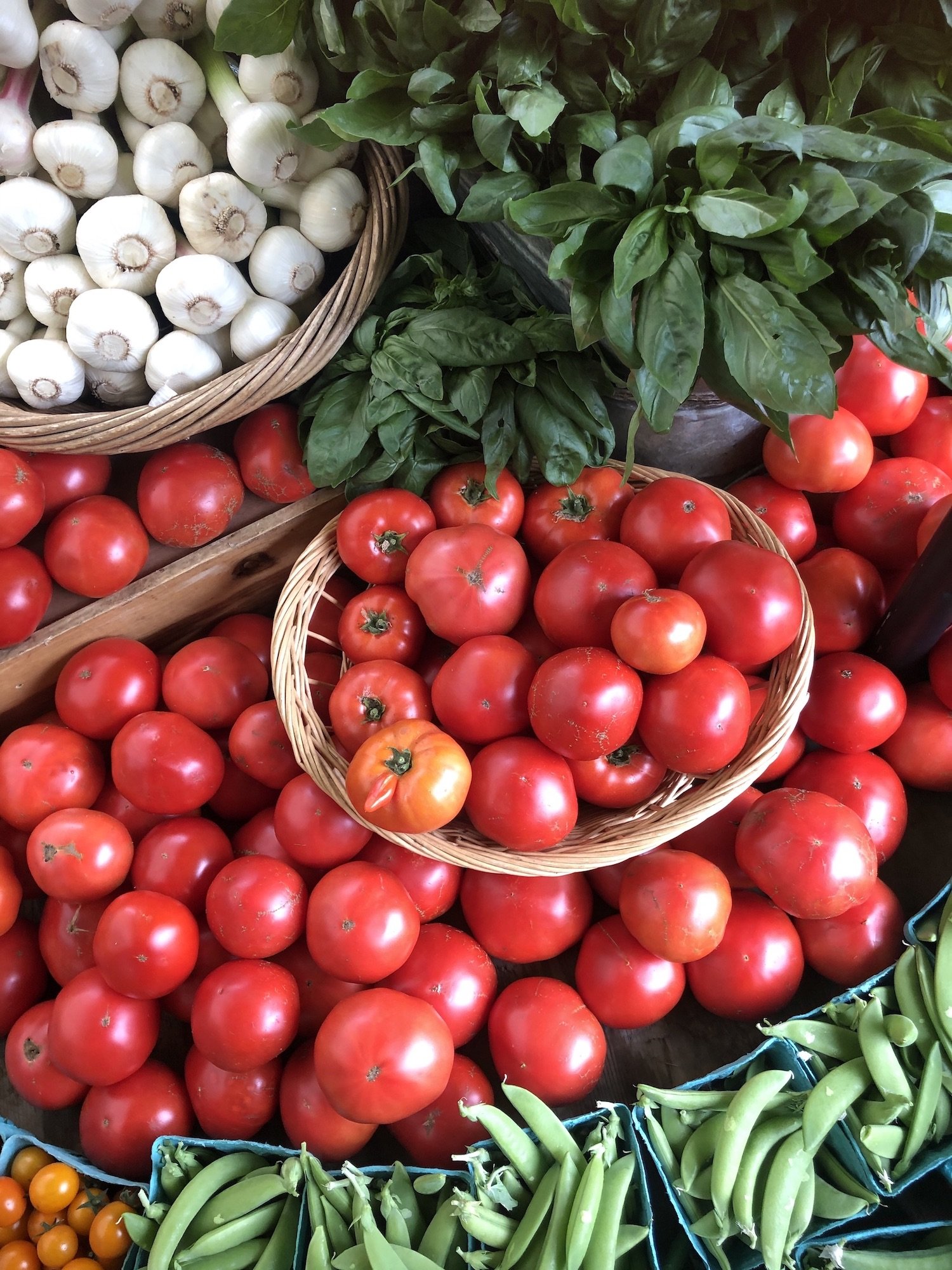
Tomatoes
Solanum lycopersicum
Absolutely luscious tomatoes from Eloisa Organic Farm on display at the Portland State Farmers Market, Summer 2021









DIGGING DEEPER — On Tomatoes
With over 7,000 varieties of tomatoes taking so many shapes, colors, and sizes, no one can deny how much humans love their tomatoes. Although often associated with Italian food, tomatoes originated from South and Central America. Just like the rest of its relatives in the Solanaceae family, tomatoes are some of the sweetest treats of summer and the base of cuisine around the world, yet they also have a darker side.
Big or small farm alike, tomatoes tend to be the money maker on many farms, and it is a hot, dangerous race all season long to catch these fruits of the sun faster than they drop. California alone is responsible for a third of the world’s tomato production, Florida coming in second in the US.
Tomato harvest is done in large part by Indigenous and Latinx farmworkers who still work in conditions that echo this country’s history of slavery. The system is in large part is made possible by racist immigration policies which continue to be a low priority for many “food activists.”
I think a lot about the way that we often associate gratitude with food. We pray at meals and count our blessings, feel grateful to have the food on the table. Gratitude is a medicinal mindset that can help us keep going every day, it is the nourishment that we get through sharing a meal with our loved ones, the unquantifiable nutritive content of the meal.
But it’s important to feel and acknowledge the other side of gratitude, and that is responsibility. I don’t think any other crop embodies the duality of gratitude and responsibility like the tomato does.
A lot of us who have come to adore the moment that tomatoes come into season, to huddle around a plate of first caprese salad of the year and gleefully drip messy slices of the fresh fruits to our faces, sometimes we fall into the trap of thinking that that moment of bliss is perfection. The tomato was local, it was organic, and maybe you even got it from your local farmers market.
I want to make two points very clear that I think are quite common misconceptions within our local food movements. First, if we assume that migrant farmworkers are are not harvesting our local organic tomatoes and that we’re supporting a more ethical kind of farming, then we missed something. The alternative local food movements that have gained popularity over recent decades are only accessible (for both farmers and consumers) to a very small, largely white and privileged population. They have historically not done much to change the industrial food systems that farmworkers are still working on. Buying local didn’t change immigration law and policy.
Second, if, on the other hand, we assume that migrant farmworkers are also the leading labor force on our small organic farms that sell at farmers markets (which is the truth), we probably assume that their working conditions are lightyears better than on big industrial farms. While there is some validity in this assumption, in large part, the experiences of farmworkers on small local organic farms differs very little to those on conventional operations. There is much systemic and interpersonal racism that is unaddressed regarding labor in agriculture, industrial and local/alternative/organic alike, and much to be done on the statewide and federal levels to change the policies that control farmworkers’ lives and keep them from having basic human rights.
Learn More
Tomatoland: How Modern Industrial Agriculture Destroyed our Most Alluring Fruit by Barry Estebrook
PCUN: Pineros y Campesinos Unidos del Noroeste (Oregon’s Farmworker Union), OR
Tomato Index
While there are literally thousands of varieties of tomatoes and the lines get blurry between one type to the next, in general there are the following categories:
• Cherry Tomatoes • Romas & Slicer Tomatoes • Heirloom Tomatoes • DRY-FARMED TOMATOES •

Cherry Tomatoes
Brilliant Jeff Sungoldbloom image from Hello Harvest Queen, Bay Area, CA
These dainty little sugar bombs are straight up just fun, always a joy to have in the garden, and always a pleasure to find on your plate. Eat whole right off the vine, pop into a salad or sliced up in pasta, sun dry for condensed flavor, & more!
See just a few common groups of cherries below.
-

Black
From chocolate cherries to deep black cherries, the dazzling dark side of cherry tomatoes is beautiful, tangy & sweet. (Photo - Baker Creek)
-

Red
The ubiquitous red cherry takes many forms—small grape tomatoes, large plum tomatoes, pear tomatoes, the classic round red cherry.
-

Orange
The queen of cherry tomatoes, super sweet Sungolds are the most sought after cherry tomato at markets, known for their crazy high sugar content.
-
Yellow
Bright yellow cherries come with a lovely balance of tart & sweet, and range in a variety of shapes & sizes from round to oblong to pear-shaped fruits.
-

Pear
Super sweet cherry tomatoes that have a luscious juicy pear-shape, a fun plant to have in the garden, easy to pop off the vine & enjoy. (Photo - Burpee)
-

Heirloom
From gorgeous striped toms with a long oblong shape with a pointed tip, to round and rumply mini-heirlooms that are almost too pretty to eat!

Romas & Slicers
These predominately red tomatoes are the bases of salsas, sauces, and incredible dishes all around the world, but particularly throughout Central and South America where tomatoes originated from. With less bells and whistles than whimsical cherries or extravagant heirlooms, these ripe red tomatoes will never cease to amaze.
See just a few common romas & slicers below.
-

Roma
The best sauce tomato of them all, romas are known for their low water content and rich flavor. Easy to roast, pop off the peels, & process into your sauce of choice.
-

San Marzano
This variety of roma tomato is more elongated with a pointed tip and is known for having a particularly extra sweet and rich flavor. A prized sauce tomato at market.
-

Siletz
This early season red slicer is small to medium sized and for an early tomato it arguably is the best tasting tomato of the season. Siletz are prone to
-

Early Girl
This smaller round red slicer is known for having a dainty pointed tip and a super sweet flavor and juicy texture. Perfect early season tomato. (Photo - Johnny’s Seeds)
-
Big Beef
Also known as Beefsteak, these red slicers are quite large with a stiffer texture when ripe, making for nice big round slices that hold up nicely on sandwiches and burgers.
-

Orange
There are many different varieties of orange slicer tomatoes, all of which tend to have a super high sugar content and mild acidity, making for a beautiful and tasty addition to salads.

Heirloom Tomatoes
Heirloom tomatoes include thousands of varieties that vary greatly from the red tomatoes we see in grocery stores. Ranging greatly in size, heirlooms are known for their humungous wonky gorgeous fruit, almost meat-like, an aortic pump of a Solanaceous kind. Add these tomatoes to any dish to dazzle the eyes and the palette.
See categories of heirloom tomatoes below.
-

Black
Common varieties include Purple Cherokee, Paul Robeson, and Crimson. Shades vary in color but all tend to be a deep purple tomato that can be very large, rumply or round.
-

Red & Pink
Harvesting heirlooms feels like harvesting a cut of meat, an aortic pump of a vegetable kind, that one must approach cautiously with clippers to avoid poking the pristine fruit.
-

Yellow
From bright canary yellow tomatoes to red-blushed fruits, there are dozens of yellow heirlooms just waiting to brighten up your plate in slices of every wonky shape & size.
-

Orange Stripe
This Solar Flare is one of many juicy orange-yellow-red striped heirloom tomatoes that range from round to wonky, tend to be larger, and both tangy and sweet. (Photo - Baker Creek)
-

Green
This Green Zebra tomato is a smaller round striped green tomato with an incredible sweet-tart flavor and juicy texture. There are also larger and lumpier green varieties.
-

Purple Stripe
This Pink Berkeley Tie Die is one of many darker striped heirlooms, but it is unique with its iridescent green stripes. (Photo - Rainbow Harvest Farm)

DRY-FARMED TOMATOES
Dry-farming is the practice of farming with little to no irrigation. As climate change moves us toward hotter and hotter summers and irregular precipitation events, the need to develop varieties that do well without irrigation is essential. In addition to being incredibly environmentally important, dry-farmed tomatoes happen to have the best flavor you could every imagine! Smaller fruits are less diluted with water and have an incredibly condensed, sweet, almost sauce-like flavor. Just about any crop can be dry-farmed, but dry-farmed tomatoes are becoming quite the hit at markets.







“This is delicious when eaten straight away, but you can also make the salad, cover it and refrigerate for up to 4 hours. This way all the flavors marry & mingle, making for an even more delicious salad. If you are planning to make a day or two ahead of time, keep the tomatoes and the walnuts separate until you’re ready to serve so they remain crisp.” — Inspired Taste